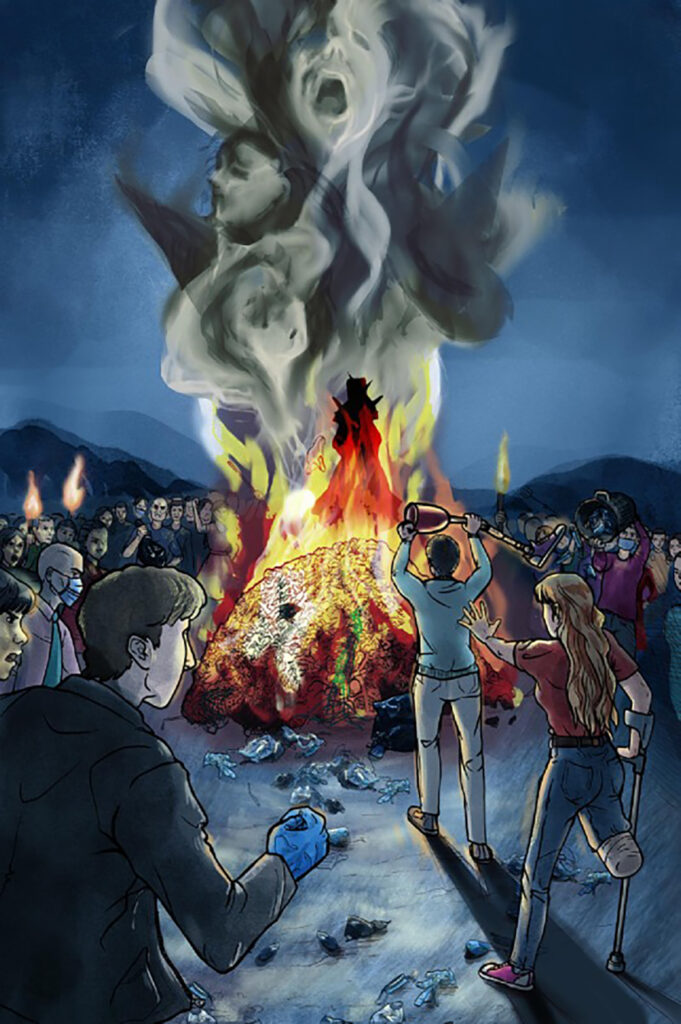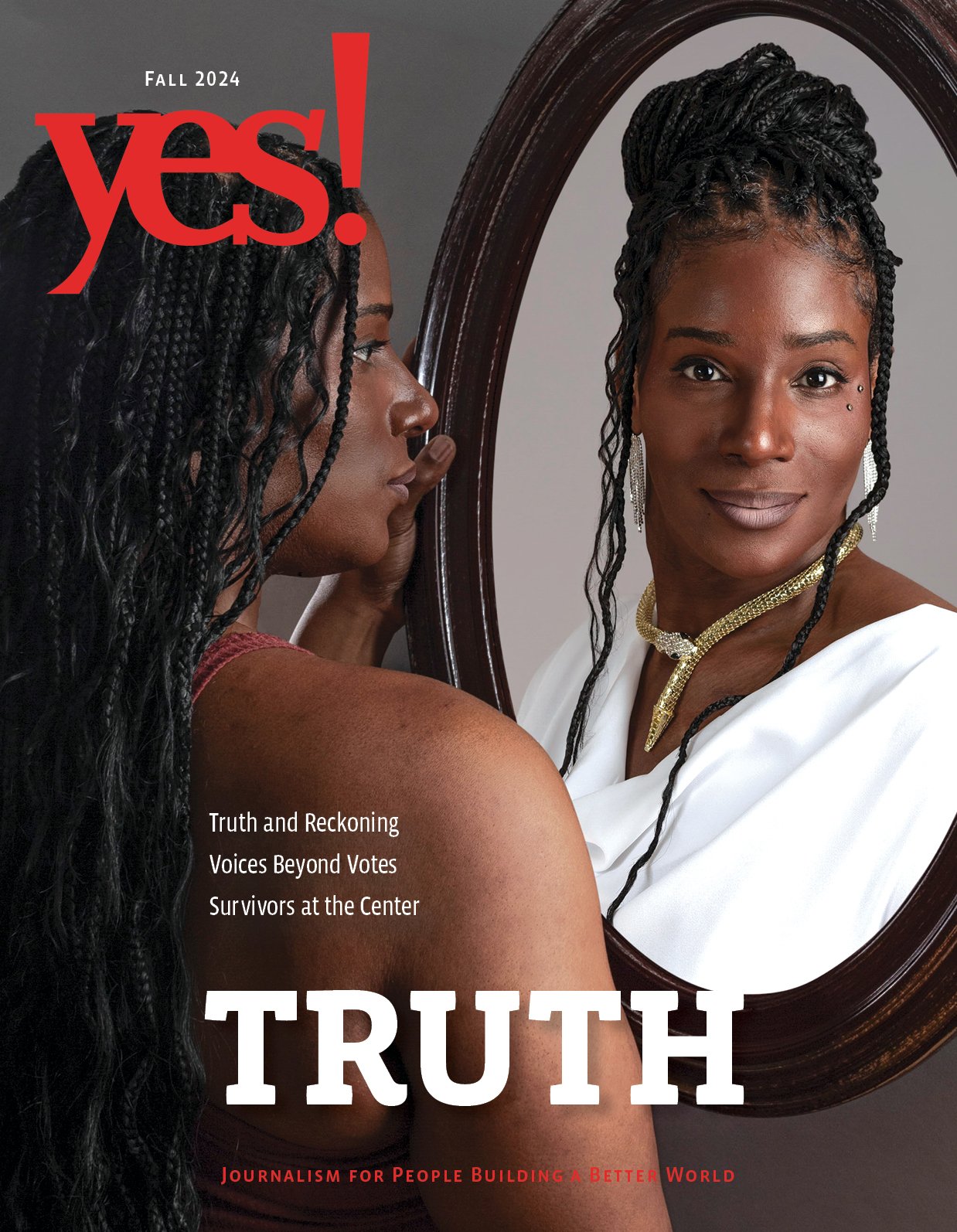Finding Climate Solutions in Fairy Tales

Can traditional tales help us think productively about contemporary environmental issues? We have been exploring how fairy-tale tropes and archetypal characters offer new ways to articulate important questions. So sit back and let us tell you a story…
Fever: An Old-fashioned Tale About Modern Problems
In that town, the people know all kinds of spells. There are spells for protection, spells for assistance, spells for small wonders.
Those who tend the sick know the magic words which will keep you safe from fever. The traveling merchants know the incantation to shield you from the poxes that swirl in other towns. One spell lightens the load in your cart so your horse trots along as if he were pulling nothing at all. Here, a little cantrip that conjures a basket to carry home your bread. There, a charm to preserve the herbs you carry to market; when you arrive they’re as crisp and fresh as when you picked them that morning. And simply murmur the right words, and the water in your cup will flow to your lips, bubbling upward like a waterfall being reeled in. The children giggle as they drink, and others find relief in being able to drink so effortlessly. What a world it is: magic to salve, to ease your path through life, to dazzle and delight.
People will accept almost anything if it’s just the way things have always been.”
No one in the town remembers asking for such marvels, and none of them can explain quite how they came to have all this ordinary magic. It’s been around so long, handed down and shared around, that it’s woven into their lives now. They only know that the witch who lives on the hill, or some other witch, once gave them these spells and charms, drawing her power from wherever witches find it. (And no one could quite tell you where that is. Although some do say that the witches’ magic comes from deep in the earth, that it’s the breath of the first living things. That if you were to see the magic, it would be dark like peat. Black with uncountable years.)
Everyone knows, of course, that there’s a price to pay for these small wonders. The witches have always been clear about this. Nothing comes for free in this world. Just like life, magic is a balance, and the universe needs to settle its ledger. Meet a need today, savor a small luxury, and you might encounter some little misfortune tomorrow. It sounds unpleasant, but it’s not hard to understand how the people accept it. Oftentimes, the price comes due so long afterward that it doesn’t seem related at all. Or perhaps it pops up elsewhere, far away, causing some other person to stumble or trip instead. True, it’s a haphazard sort of accounting, but people will accept almost anything if it’s just the way things have always been.

In this way life proceeds unquestioned, until who knows what it is that finally cracks and starts the dam bursting. Because, lately, the discomforts have begun to trouble the people. The small misfortunes seem to mount; they feel bothersome and close by.
Take the stream, for instance: Once it flowed cleanly, but now it overflows its banks, and foul water floods the paths. Sometimes, the people find their own animals have been swept away by the currents and drowned. The people always knew the magic came with a price, but the small misfortunes don’t seem so small anymore. And what else are they to conclude but that it’s the fault of the witch and the silly magic she gave them?
When the people meet in the marketplace, they mutter about the spells of convenience: those devilishly crisp herbs, the bewitched bread baskets, the sorcery of that up-tumbling water. Why, they grumble, did the witch ever offer them such absurdities? They curse her wicked, sticky magic. It should have stayed where it belonged, they say, deep in the earth’s hot belly.
The witch knows what is brewing. When she passes the townspeople in the woods or in the market, she hears them muttering and seething. She’s seen their eyes flash with fiery resentment. And she knows it won’t be long before they confront her, fueled with righteousness, ready with their hot words.
She knows that bargains can sometimes be struck with the cosmic ledger, that nothing is set in stone.”
They’re angry about the spells that seem so frivolous, so extravagant. They forget, for now, all the others that heal and ease. Even so, she knows that something has to change. The people could use fewer spells, but there’s more to it than that. Perhaps, after all, the old magic has run its course. Perhaps it’s time to craft new spells that don’t carry so steep a price.
She’s heard of one incantation that could protect 40 people from fever before any harms would be incurred. And she might be able to make a charm to shield not just one person but the whole town from poxes. The healing spells have always come with a cost, but it doesn’t have to be that way. She knows that bargains can sometimes be struck with the cosmic ledger, that nothing is set in stone.
From her window, she can see the people’s faces flickering in the torchlight as they climb the hill to her little house. Soon they will hammer on her door, feverish with indignation, demanding she account for herself. But who knows if they will want to hear what she has to say. In the white heat of rage, people don’t always want to sit and talk. It can seem like the only answer is to burn things down.
Although, sometimes, it’s also right there in the heat of the crucible that the world might be reimagined. Where we can dismantle the old ways and forge something brand new.
We know that when it comes to the wicked problems of climate change, biodiversity loss, and pollution we need to shift worldviews. “And the most advanced tool we have to change worldviews—to transform people’s attitudes, values, and structures of perception—is called the story,” writes Marek Oziewicz, professor of children’s and young adult literature.
As Will Storr, author of The Science of Storytelling, reminds us, folktales have been used to communicate social codes and establish moral norms since humans first formed societies. Whoever tells the stories defines the agenda: the framing of our common issues and enemies.
“Fever,” the story that opens this piece, is about the magic of plastics, which we take for granted today. IV bags, tubes, and personal protective equipment (PPE) have revolutionized medical procedures and saved lives through reduced contamination risks. Plastic packaging has also transformed our ability to keep food from spoiling and thereby wasting the resources involved in planting, fertilizing, harvesting, and transporting those goods.
Yet we can no longer look away from the accumulated impacts of plastic pollution. And as a result, we often blame consumers for choosing plastic bags or plastic straws. Instead of individualizing responsibility, in “Fever” we articulate a tale that gets us wondering about broader systemic changes required of manufacturers and petrochemical companies.
There is no singular, standardized account of plastic’s history. Some point to the seeking of alternatives to ivory and elephants’ tusks for billiard balls, others to a repurposing of military materials fueling a postwar boom. Either way, plastics were not initially designed for single use. Yet, as a result of their explosion onto the scene in the 1960s, plastics have become a driver of global oil demand and a market for expanded growth by fossil fuel companies.
One of the major issues with plastics is that there is inadequate research on their health impacts, and a lack of labeling on the more than 10,000 different chemical substances used in plastic production. We know occupational disease affecting generations of workers as well as waste pickers, sorters, and recyclers is cause for concern. And, thankfully, these chemicals’ toxic bearing on human health remains part of the global plastics treaty currently being negotiated.
This sort of collective, upstream regulation is what is actually required to balance the cosmic ledger. Recent modeling shows that even with a massive expansion of waste infrastructure, we cannot keep pace with the increasing speed and volume of plastic production. We have to look at how to stem the flow upstream. As such, another key systemic intervention we need to implement, and without delay, is making the polluter pay through Extended Producer Responsibility.
For example, in the U.K., businesses pay only 10% of the disposal cost of plastic packaging, with the remainder subsidized by council tax. That’s U.K. residents paying so that businesses can save money by delivering their products in inexpensive, disposable containers. If businesses were paying the additional 90% through Extended Producer Responsibility, it’s not hard to imagine that companies would be motivated to innovate different products and services with less waste.
Because, as Max Liboiron, author of Pollution Is Colonialism, eloquently argues, the concept of disposability—including recycling—is dependent on the idea that we can send unwanted materials away. Indeed, there is continued violent enactment of this colonialist approach when one considers landfills and dumps being sited in or near Indigenous communities and communities of color.
It’s time the polluters pay for the creation of systems that maximize the value of this magical family of materials. We don’t need to burn all plastics at the stake to make meaningful change; instead we need to look at the broader systems around how we manufacture, use, and dispose of plastics. In this way we can find ways to live with them (perhaps happily ever after).
Stories can help us create universal climate literacy and find united agendas. We need tales of collective action and of finding well-being in doing less. We need tales that inspire activism and mobilize visions of joyful, low-impact lifestyles. It’s time to rewrite some traditional tales in service of the people and the planet.
Note: The fairy tale, Fever, was written by Becky Tipper based on the academic research by Katherine Ellsworth-Krebs and her colleagues.
|
Katherine Ellsworth-Krebs
is a social climate scientist based near the Lake District, researching low-carbon living in high-income countries. Her desire for answers on how to live sustainably led her from her childhood home in Seattle to Scotland, home to the UK’s flagship sustainability degree. Katherine has a BSc and PhD in Sustainable Development from the University of St Andrews where she also co-founded both a Transition Town and a bike rental scheme. For nearly a decade she has lectured on sustainable consumption and climate activism at UK universities. Her peer-reviewed papers and personal essays have appeared in Nature Energy, Literary Veganism, Fast Company, among others. Most mornings she can be found with muddy knees watering in the greenhouse or recording content for her podcast Joyful Climate Writing.
|
|
Becky Tipper
is a writer of fiction and non-fiction and holds a Ph.D. in Sociology from the University of Manchester. She has worked on several collaborations with social researchers, aiming to communicate findings and concepts through short stories. She is currently writing a book exploring creative ways in which researchers in academia and beyond can harness the power of storytelling and fiction.
|






